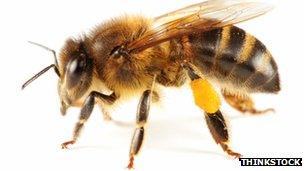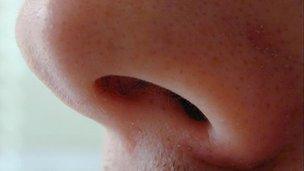Has the sniffer dog had its day?
- Published

Dogs have always been relied on by police and security services for sniffing out drugs and explosives, but has science managed to find a better replacement, asks Amber Marks?
From locating decomposing bodies to illegal drugs, smells often provide vital clues for the detective.
Those smells have traditionally been detected using the extremely sensitive sense of smell of dogs.
For the sheer variety of substances they can detect, dogs are vital, says handler Sgt Adam Turner.
"The dog can currently detect 10 different substances from homemade explosives to manufactured substances. We can detect a huge range of size and substances," says Turner.
But scientists are now asking whether dogs are best for the job?
"Like humans, dogs get tired, they get bored, they need breaks every so often," says Prof Ken Grattan of City University.
Grattan's team is working on a sensor-mounted robot - called the cargo-screening ferret - with an artificial, programmed sense of smell that will better a dog in sniffing out illegal substances.
"Every sniffer dog has to have a handler, so you have the cost of the person and the dog. If you can automate this the great advantage is you can run the robot 24 hours a day," continues Grattan.
The ferret's sensors consist of chemically coated optic fibres. The chemical coating is designed to glow on coming into contact with target substances.
But like all artificial noses, the ferret has three main drawbacks.
It does not sniff of its own accord and it is only capable of detecting the limited range of odours that chemists have designed it to react with.
The robot nose also has difficulties telling between different combinations of smells, which can prove vital.
Because scientists' catalogue of chemical signatures is incomplete, some experts believe the answer still lies in the natural world.

Heroin or cannabis? The honeybee decides
"The advantage of the animal," Gary Beauchamp, a professor at Monell Chemical Senses Centre, "is that they have developed through evolution the optimal way of identifying odorants, categorising them and putting them into patterns.
"If we can understand this, we could build a device that could do much of this."
Although research suggests that smells communicate as much information as other sensory stimuli, olfactory science - the study of smell - remains the least understood.
"We don't yet know how we build up a picture world of smell in the same way we do with vision or hearing," says Beauchamp.
Scientists know humans have millions of odorant receptors but not how the molecules that make up smells interact with the receptors, or how the brain interprets these interactions.
Though great progress is being made, these limitations are causing many scientists to now focus on how to use technology to harness the smell systems present in nature, rather than design technology that attempts to copy it.
And these scientific advances are now moving beyond canine noses.
In east Africa, a Belgian company working in conflict zones has <link> <caption>trained giant pouched rats to locate minefields</caption> <url href="http://news.bbc.co.uk/1/hi/business/8549681.stm" platform="highweb"/> </link> using smell. The rats have the advantage of being light enough not to trip the mines.
And researchers have proven it is possible to train moths to search for cannabis using their sense of smell.
But it is the humble honeybee that is at the forefront of the research to aid detection of dead bodies, drugs, explosives and counterfeit money.
"The inherent algorithm associated with the brain of the honeybee, as well as their antennae, collectively are a sensor," says Robert Wingo of the Los Alamos Natural Laboratory.
"We just needed to figure out a way to extract a signal from that sensor."
Wingo and his team have just finished a successful three-year study, funded by US Homeland Security, into bees' skill in sniffing out security threats.
And scientists are finding insects are faster learners than dogs.
Using simple Pavlovian training methods, bees can be trained to associate a variety of scents with food sources.
"I press a button to give the bee a scent, then use a cotton bud to put sugar by its antennae," says Inscentinel bio-sensor scientist Stacey Kendall
"When they stick their tongue out you can feed them. Pairing the sugar with the smell means they will learn."

Sensing smell is a highly complex biological process that science finds hard to replicate
A honeybee can be trained to react to a single odour in just six seconds, although the cycle can require repeating up to five times for slower learners.
To detect a particular scent like explosives, a number of trained bees are then placed inside a hand-held detector.
The bees extend their tongue anticipating food when they detect the target odour. The detector is equipped with cameras and computer software to translate the bees' responses and guide the human handler to the source.
Wingo is convinced by the potential of bees.
"We have used our honeybee-based smell system to detect explosives, for narcotics.
"One time we trained them to detect me. We did a line-up with other volunteers and we walked our sensor box up and down the line and sure enough they detected me," says Wingo.
Such success may offer a future where sniffer bees rather than sniffer dogs become a more familiar sight where police are detecting smells.